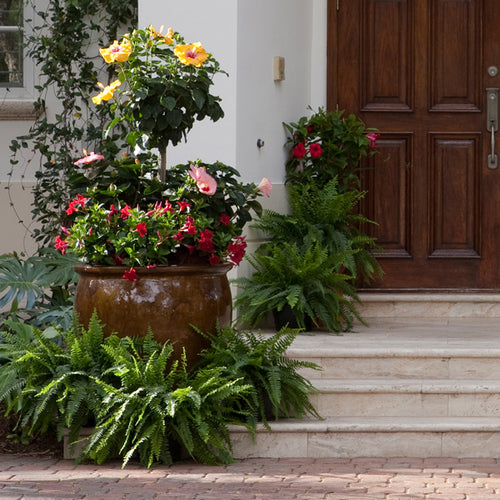
Space isn't a creative restraint
A small yard doesn’t mean that you have to forgo creative flourishes and a lot of exciting plant material. Chris Turpen, an urban landscape designer in Minneapolis, MN, believes you can think big in small spaces, and he practices what he preaches in his own yard. “The average size of the gardens I design are a 20 x 30 foot square,” he says. That’s because the average lot in south Minneapolis where he lives and works is 30 x 80 feet. “That gives me two side gardens and two square gardens, which are the front and back yard.” Here are the ways Chris uses design savvy and the right plants to achieve a pleasing garden in a small space.
Think big
My design thinking is Go Big or Go Home,” says Chris. To do this, he brings in elements that are oversized for a small space. “My arbor is big, but creates an intimate space in the yard,” he says. The white, timber frame arbor is a large structure in a small space. But it serves as a landscape anchor. The open roof makes the space underneath feel open. “If you don’t have an anchor in the landscape, your eye will move on.” Adding softening touches of color is also a way to dress up an arbor. “I planted ‘Balboa Sunset’ trumpet vine on the arbor and it has taken over and softened it,” says Chris. When Chris redesigned his backyard garden, he had to work with an inherited problem: a telephone pole in the back alley behind the house was the focal point. To wrestle the view away from the pole, Chris planted a white pine in his yard which is now 25 feet tall. “It keeps your eye in the garden,” he says.I go into garden designs thinking about vertical elements,” says Chris. “It gives me more opportunity to design a lush space when I can add tall plants.” He uses columnar forms of trees, such as oaks and maples, that grow tall rather than wide. “Columnar oaks—I use them every time I can,” says Chris. “They are solid and substantial. And because of their height they feel big and established. “I want a setting that says it’s been there a long time.” Columnar trees grow 10 to 15 feet wide.
Grow vertically
A seating and/or dining area transforms a small backyard into an intimate dining room. “I always design a backyard with a seating area—a spot to eat, lounge and enjoy being outside,” says Chris. Minnesota’s beautiful summers and long evenings make dining outdoors an event not to be passed up. “When I design a patio, I want a substantial space,” he says. “I always tell my clients to go as big with a patio as possible,” he says. But Chris admits that it’s hard as a gardener to give away planting space to concrete or brick. “But you can always green up a patio with containers around the edges,” he says.
Take a seat
Combining containers and iconic garden ornaments create vignettes on patios and tabletops that drive garden style. Chris uses decorative elements and found objects in neutral tones— classic urns, terra-cotta pots, and concrete balls—allowing flowers and foliage to deliver the message of color and texture. Combinations of pots also creates small focal points within a seating area.
Create vignettes
Chris turns to perennials as the backbone of his own garden—and all the gardens he designs. “I use almost exclusively perennials,” he says. Because many of the lots in the neighbors he works in are deeply shaded, he employs the species that excel in the shade. “I use big hostas,” he says, because he likes how leafy and large some get. ‘Sum and Substance,’ for example, grows 5 feet across. In a shaded side yard, that’s a big plant. Other shade perennials? Chris uses a paintbox of colorful ferns, astilbe, heuchera, and heucherella.
Use long-lasting perennials
The compact and moveable nature of containers, mean that you can snug them in anywhere—and Chris uses them a lot in his garden designs. Filled with tropical plants, such as colorful crotons, containers add a flourish of foliage to decks, porches, patios, and even borders, which is especially important for welcoming summer in Minnesota’s short-but-brilliant summer. At the end of the season, tropical plants can go indoors. For pops of color, “I use big pots of colorful annuals and perennials,” says Chris.
Add foliage-filled containers
A long narrow space, such as a side yard, is hard to make look beautiful. “I like to break up space with arbors,” says Chris. Their decorative structure creates a visual stop in the long, narrow flow on each side of the house in a narrow city lot. “An arbor cuts across the space, so the side yard doesn’t look like a bowling alley,” says Chris.
Create a visual distraction
In a small space, such as a slender side yard, Chris employs a thematic approach. “A theme is easy to pull off in a smaller space.” In his own yard, Chris added iconic Asian elements and plants to create a little strip of Zen. Plants include clipped cedar, pagoda dogwood, and Japanese forest grass. Simple ornaments, such as an pot, reinforce the theme. A side yard is ideal for this type of outdoor décor, he says. “It would be too much in the front yard.”
Use a theme
In a small lot, things can overgrow their spots. (This happens in all successful gardens.) But you shouldn’t be afraid to make edits, says Chris. “Sometimes you need to take things out if they grow too large or oddly,” he says. For example, even though columnar-form trees grow vertically, they cast shade as they get bigger. That may mean replacing sun-loving plants with shade-preferring ones. Or it might require reshaping garden beds as the light changes.Photo credit: Chris Turpen, Slides 1, 2, 4, 5, 9, 10

Edit as things grow
NULL
















